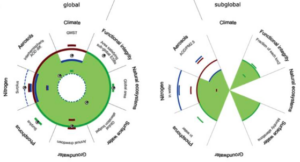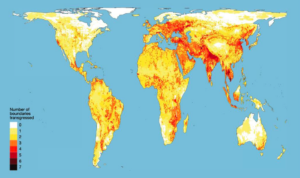Griffith researchers collaborated on new study that shows humans are taking colossal risks with the future of civilization and everything that lives on Earth.
Published in Nature, researchers from across the globe delivered the first quantification of safe and just Earth system boundaries on a global and local level for biophysical processes and systems that regulate the state of the Earth system.

"For the first time, we have assessed safety and justice for humanity on Earth, quantifying some of the key variables regulating life support and Earth system stability," said author and member of the Earth Commission, Professor Stuart Bunn from the Australian Rivers Institute.
"By incorporating justice, the idea of avoiding significant harm to people across the world, into our assessment of Earth system boundaries, it further tightens safe operating range for humans on Earth with regard to climate, water, biosphere, nutrient use/cycle and pollutants."
As this research convened by the Earth Commission concludes, this is extremely challenging because several of these safe boundaries have already been crossed.
"We are in the Anthropocene, putting the stability and resilience of the entire planet at risk. This is why, for the first time, we present quantifiable numbers and a solid scientific foundation to assess the state of our planetary, health not only in terms of Earth System stability and resilience but also in terms of human wellbeing and equity / justice." said Prof. Johan Rockström, Earth Commission Co-Chair, lead author and Director of the Potsdam Institute for Climate Impact Research.

Justice tightens the available space for humans on Earth
The Earth system is an interconnected set of biophysical processes that operate across regions and scales, where interference in one part of the world can have enormous impacts on other regions.
This study builds on the scientific evidence defining the biophysical conditions to maintain a stable planet to underpin life on Earth by providing safe and just earth system boundaries for five critical domains that play a key role in life support and Earth stability. It also explores what is needed to minimise significant harm to humans due to changes in the Earth system.

"Safe boundaries ensure stable and resilient conditions on Earth and use an interglacial Holocene-like Earth system functioning as a reference point for a healthy planet," said co-author and Earth Commission staff member, Dr Ben Stewart-Koster, from the Australian Rivers Institute.
"Some boundaries, such as surface and groundwater flows, are designed to protect ecosystems and ecosystem services on which communities rely."
A stable and resilient Earth is dominated by balancing feedbacks that cope with buffer and dampen disturbances. Cutting edge science on climate tipping points feature as one major line of evidence to set safe boundaries.
Just boundaries minimize human exposure to significant harm or irreversible negative impacts on countries, communities and individuals from Earth system change and ensure minimum access to resources for people.
The Safe and Just boundaries take the stricter of the two quantified levels.
For a safe future, the world needs global targets beyond climate
Global target setting has focused on climate change and limiting global warming well below 2°C and aiming at 1.5°C according to the Paris Agreement. The world has already passed the safe and just climate boundary, which is set at 1°C above pre-industrial temperature levels, as tens of millions of people are already harmed by the current level of climate change.
Science also clearly shows there is a need to manage all the other biophysical systems and processes on Earth that determine the liveability on the planet.

Health indicators for people and the planet
The quantified safe and just boundaries for other biophysical systems such as biodiversity, freshwater and different kinds of pollution to air, soil and water have also mostly been breached.

For example, human activities are altering water flows, excessive amounts of nutrients are released into waterways from fertiliser use, and limited natural areas are left.
"Human activities are altering surface water flows, and unsustainable groundwater pumping will lead to rapid declines in groundwater storage, jeopardising global food security, and decreasing ecosystem resilience to drought as well as causing the loss of groundwater-dependent ecosystems", said co-author, Dr Christopher Ndehedehe from Griffith University.
"These pose existential threats for a stable planet, to ecosystems and their vital contributions to people."
"The results of our health check are quite concerning: Within the five analysed domains, several boundaries, on a global and local scale, are already transgressed. This means that unless a timely transformation occurs, it is most likely that irreversible tipping points and widespread impacts on human well-being will be unavoidable. Avoiding that scenario is crucial if we want to secure a safe and just future for current and future generations," continued Rockström.
Science for real world application
"The Earth Systems Boundaries need to be translated so that businesses, cities, governments and civil society can understand their share of resources and responsibilities", said co-author and Earth Commission staff member, Syezlin Hasan from the Australian Rivers Institute.

"This will underpin the setting of actor-specific science-based targets to address increasing human exposure to the climate emergency, biodiversity decline, water shortages, ecosystem damage from fertiliser overuse in some parts of the world coupled with lack of access elsewhere, and health damage from air pollution.
In a time of increasing scrutiny and expectations, the resilience and success of businesses, cities and governments will depend on their ability to accurately measure their resource use and environmental impacts and take swift actions towards reducing their negative impacts on people and planet. This can enhance their ability to take advantage of opportunities that arise within the finite limits of the planet.
"A safe and just transformation of the planet requires urgent, collective action by actors within governments, cities and businesses to move us back within Earth system boundaries and keep our planet's life support system intact," Professor Bunn said.
"With this global scientific assessment, we provide all stakeholders with scientific boundaries that can enable a prosperous and equitable world development on a stable planet, a better future for people and planet. This new science functions as input to the development of science-based targets. These can be adopted by cities, businesses and countries to address the systemic global crises of climate change, biodiversity loss, nutrient overloading, overuse of water, and air pollution." concludes Rockström.






